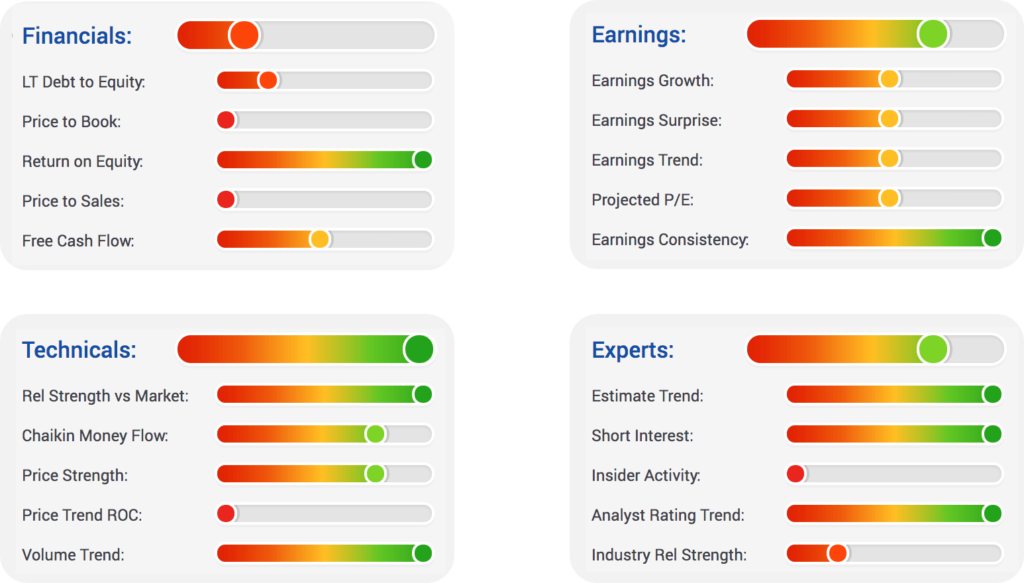Components and Factors
The following are the 20 Power Gauge Factors, grouped into 4 top-level categories.

These can be seen by expanding the chart header.

Each factor begins with a raw value, made consistent across various stock types. It's then assigned a score from 1 to 100 based on how it ranks within either the Russell 3000 or the stock's Industry Group. These factors are chosen for their ability to predict performance.
These factors are blended using our unique weighting system to create a raw rating. For stocks with strong trends, this rating is adjusted to produce the ultimate Power Gauge Rating.
FINANCIALS | |
| LT Debt to Equity | Long-term debt to equity ratio measures a company's financial leverage by comparing its long-term debt to its shareholders' equity I the latest quarter. |
| Price to Book | Price-to-book ratio compares a company's current market price per share to its book value per share, indicating how the market values the company relative to its net assets of the latest quarter. |
| Return on Equity | Return on equity (ROE) measures a company's profitability by calculating its net income over the last 12 months as a percentage of shareholders' equity, indicating how effectively the company is utilizing shareholder equity to generate profits. |
| Price to Sales | Price-to-sales ratio compares a company's market capitalization to its total revenue over the last 12 months, indicating how much investors are willing to pay for each dollar of the company's sales. |
| Free Cash Flow | Free cash flow (FCF) represents the cash generated by a company's operations over the latest quarter after accounting for capital expenditures, indicating the amount of cash available for distribution to shareholders, debt repayment, or investment in growth opportunities. |
EARNINGS | |
| Earnings Growth | Earnings growth refers to the rate at which a company's earnings, typically its net income, increase over a specific period, reflecting its ability to generate greater profits over a weighted average of 3-5 years. |
| Earnings Surprise | Earnings surprise refers to the difference between a company's actual earnings per share (EPS) and the consensus analyst estimates for those earnings, indicating whether the company outperformed or underperformed expectations in a weighted average of recent quarters. |
| Earnings Trend | Earnings trend refers to the direction and pattern of a company's earnings over the last year, providing insight into whether earnings are increasing, decreasing, or remaining stable over time. |
| Projected P/E | Projected price-to-earnings (P/E) ratio estimates the future valuation of a company by dividing its projected future earnings per share (EPS) by the current market price per share, indicating investors' expectations of the company's future earnings growth over the next fiscal year. |
| Earnings Consistency | Earnings consistency refers to the stability and predictability of a company's earnings over time, reflecting its ability to generate steady profits regardless of market conditions or economic cycles. |
TECHNICALS | |
| Rel Strength vs the Market | Relative strength versus the market measures how a particular stock or asset performs compared to a broader market index over the last 6 months, indicating whether it outperforms or underperforms the overall market benchmark. |
| Chaikin Money Flow | Chaikin Money Flow (CMF) measures buying or selling pressure in a security by analyzing the relationship between price and volume over the last 6 months. |
| Price Strength | Price strength measures the degree or intensity of upward movement in the price of a security, calculated by comparing the ratio of closing prices to its 200-day exponential moving average, often indicating the bullish momentum or robust performance of the asset. |
| Price Trend ROC | The Price Trend Rate of Change (ROC) shows how much a stock's price has changed over 42 days compared to its LT Trend, indicating how fast its price is moving. |
| Volume Trend | Volume trend refers to the direction and magnitude of trading volume associated with a security, calculated by the ratio of the 30-day to 90-day average daily volume, providing insight into the strength and sustainability of its price movement. |
EXPERTS | |
| We have found that stocks with Very Bearish Power Gauge ratings are at higher risk for negative earnings surprises, and the converse is true for Very Bullish ratings. This is because Power Gauge factors, such as those in the Expert Opinions component, look at the activity of various market participants like Analysts, Short Sellers, and Company Insiders who may have a more accurate picture of a company’s earnings dynamics. You can use this fact to help position you ahead of earnings announcements. | |
| Estimate Trend | Estimate trend refers to the direction and pattern of changes in analysts' earnings or revenue estimates for a company over the last 13 weeks, indicating shifts in expectations regarding the company's future financial performance. |
| Short Interest | Short interest represents the total number of shares of a security that have been sold short by investors in the previous month but have not yet been covered or closed out, serving as a measure of market sentiment and potential future price movements. |
| Insider Activity | Insider activity refers to transactions involving shares of a company's stock over the last 6 months, conducted by individuals who have access to non-public information about the company, such as executives, directors, or large shareholders, which can provide insights into their confidence or outlook regarding the company's future performance. |
| Analyst Ratings | Analyst ratings are assessments from financial analysts (outside of Chaikin Analytics) on a stock's investment potential, guiding investors with recommendations ranging from "buy" to "sell" based on various factors such as earnings prospects and market conditions. Analyst Ratings are calculated by comparing the 4-week change to analysts' average ratings. |
| Industry Rel Strength | Industry relative strength measures the performance of a specific industry or sector relative to a broader market index, indicating whether it is outperforming or underperforming the overall market benchmark. |
Note. Factors in the Earnings and Experts Components are based on data from S&P Compustat. Earnings and Estimate values displayed in the Chaikin Analytics application are sourced from S&P.